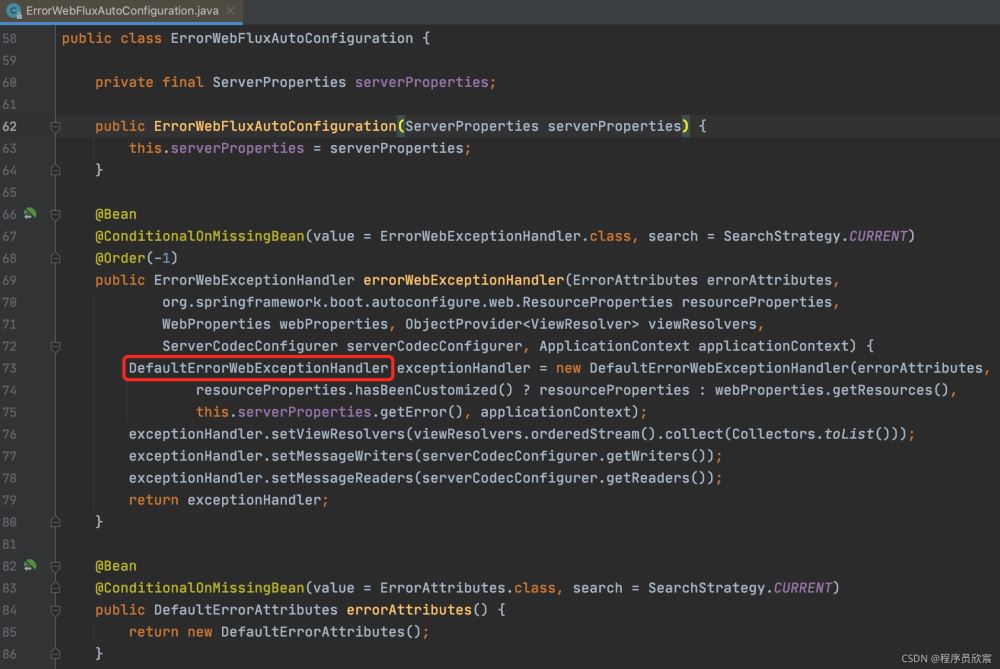欢迎访问我的GitHub
这里分类和汇总了欣宸的全部原创(含配套源码):https://github.com/zq2599/blog_demos
本篇概览在《Spring Cloud Gateway修改请求和响应body的内容》一文中,咱们通过filter成功修改请求body的内容,当时留下个问题:在filter中如果发生异常(例如请求参数不合法),抛出异常信息的时候,调用方收到的返回码和body都是Spring Cloud Gateway框架处理后的,调用方无法根据这些内容知道真正的错误原因,如下图:

本篇任务就是分析上述现象的原因,通过阅读源码搞清楚返回码和响应body生成的具体逻辑
先看异常对象是不是ResponseStatusException类型
最后看map的message字段(也就是response body的message字段),在DefaultErrorAttributes是如何生成的:
上述内容就是本篇精华,但是并未包含分析过程,如果您对Spring Cloud源码感兴趣,请允许欣宸陪伴您来一次短暂的源码阅读之旅
首先要看的是配置类ErrorWebFluxAutoConfiguration.java,这里面向spring注册了两个实例,每个都非常重要,咱们先关注第一个,也就是说ErrorWebExceptionHandler的实现类是DefaultErrorWebExceptionHandler:

处理异常时,会通过FluxOnErrorResume调用到这个ErrorWebExceptionHandler的handle方法处理,该方法在其父类AbstractErrorWebExceptionHandler.java中,如下图,红框位置的代码是关键,异常返回内容就是在这里决定的:

展开这个getRoutingFunction方法,可见会调用renderErrorResponse来处理响应:
@Override
protected RouterFunction<ServerResponse> getRoutingFunction(ErrorAttributes errorAttributes) {
return route(acceptsTextHtml(), this::renderErrorView).andRoute(all(), this::renderErrorResponse);
}
打开renderErrorResponse方法,如下所示,真相大白了!
protected Mono<ServerResponse> renderErrorResponse(ServerRequest request) {
// 取出所有错误信息
Map<String, Object> error = getErrorAttributes(request, getErrorAttributeOptions(request, MediaType.ALL));
// 构造返回的所有信息
return ServerResponse
// 控制返回码
.status(getHttpStatus(error))
// 控制返回ContentType
.contentType(MediaType.APPLICATION_JSON)
// 控制返回内容
.body(BodyInserters.fromValue(error));
}
通过上述代码,咱们得到两个重要结论:
都已经读到了这里,自然要看看getHttpStatus的内部,如下所示,status来自入参:
protected int getHttpStatus(Map<String, Object> errorAttributes) {
return (int) errorAttributes.get("status");
}
public Map<String, Object> getErrorAttributes(ServerRequest request, ErrorAttributeOptions options) {
Map<String, Object> errorAttributes = this.getErrorAttributes(request, options.isIncluded(Include.STACK_TRACE));
if (Boolean.TRUE.equals(this.includeException)) {
options = options.including(new Include[]{Include.EXCEPTION});
}
if (!options.isIncluded(Include.EXCEPTION)) {
errorAttributes.remove("exception");
}
if (!options.isIncluded(Include.STACK_TRACE)) {
errorAttributes.remove("trace");
}
if (!options.isIncluded(Include.MESSAGE) && errorAttributes.get("message") != null) {
errorAttributes.put("message", "");
}
if (!options.isIncluded(Include.BINDING_ERRORS)) {
errorAttributes.remove("errors");
}
return errorAttributes;
}
篇幅所限,就不再展开上述代码了,直接上结果吧:
private HttpStatus determineHttpStatus(Throwable error, MergedAnnotation<ResponseStatus> responseStatusAnnotation) {
// 异常对象是不是ResponseStatusException类型
return error instanceof ResponseStatusException
// 如果是ResponseStatusException类型,就调用异常对象的getStatus方法作为返回值
? ((ResponseStatusException)error).getStatus()
// 如果不是ResponseStatusException类型,再看异常类有没有ResponseStatus注解,
// 如果有,就取注解的code属性作为返回值
: (HttpStatus)responseStatusAnnotation.getValue("code", HttpStatus.class)
// 如果异常对象既不是ResponseStatusException类型,也没有ResponseStatus注解,就返回500
.orElse(HttpStatus.INTERNAL_SERVER_ERROR);
}
另外,message字段的内容也确定了:
private String determineMessage(Throwable error, MergedAnnotation<ResponseStatus> responseStatusAnnotation) {
// 异常对象是不是BindingResult类型
if (error instanceof BindingResult) {
// 如果是,就用getMessage作为返回值
return error.getMessage();
}
// 如果不是BindingResult类型,就看是不是ResponseStatusException类型
else if (error instanceof ResponseStatusException) {
// 如果是,就用getReason作为返回值
return ((ResponseStatusException)error).getReason();
} else {
// 如果也不是ResponseStatusException类型,
// 就看异常类有没有ResponseStatus注解,如果有就取该注解的reason属性作为返回值
String reason = (String)responseStatusAnnotation.getValue("reason", String.class).orElse("");
if (StringUtils.hasText(reason)) {
return reason;
} else {
// 如果通过注解取得的reason也无效,就返回异常的getMessage字段
return error.getMessage() != null ? error.getMessage() : "";
}
}
}